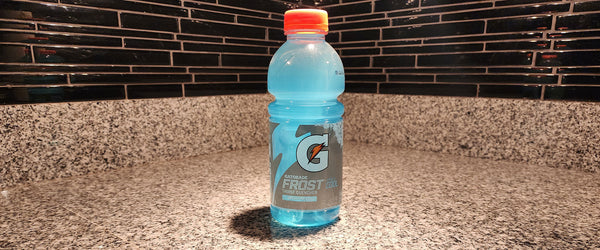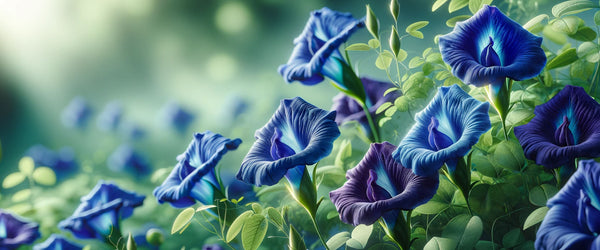Feeling Blue? Understanding Artificial Blue Dyes and Their Side Effects

Blue food might sound like something straight out of a whimsical Dr. Seuss book, but artificial blue dyes are very real components of our everyday diets. Let's shed some light on the two most common blue dyes, their potential side effects, and which foods they frequently color.
Chemical Composition and Side Effects
The two most common blue food dyes used in the United States are Brilliant Blue FCF (Blue 1) and Indigotine (Blue 2).
Brilliant Blue FCF (Blue 1)
Brilliant Blue FCF, or more commonly referred to as Blue 1 is a synthetic dye produced from petroleum. The most significant known Blue 1 side effects is its potential to cause allergic reactions, including skin rashes, hives, or nasal congestion in sensitive individuals. Additionally, while rare, there are reports of Blue 1 causing blue discoloration of the skin, urine, and feces.
Indigotine (Blue 2)
Indigotine, more commonly referred to as "Blue 2" or "Indigo Carmine" on ingredient listings is also a petroleum product. Allergic reactions to Blue 2 are less common but can still occur. Its consumption has been linked to tumor growth in mice, leading some researchers to question its safety.
The Birth of Blue
Artificial blue dye, as we know it, was first created in a laboratory in the mid-19th century. Sir William Henry Perkin, an English chemist, accidentally discovered the first synthetic dye, Mauveine, or Perkin's Mauve, while attempting to synthesize quinine, a treatment for malaria, in 1856. His discovery paved the way for the production of other synthetic dyes, including blue.
Blue Dye's Debut in the Food Industry
The use of artificial dyes in food products in the United States began in the late 19th century. The initially used dyes were derived from coal-tar, a by-product of coal processing. However, concerns about the safety of these dyes led to the Food and Drug Act in 1906, which prohibited the use of harmful colors in foods.
Following this, the certification of food dyes was introduced in 1938 under the Federal Food, Drug, and Cosmetic Act. This led to the development of the 'FD&C' color system we know today. The artificial blue dyes, FD&C Blue No. 1 (Brilliant Blue FCF, E133) and FD&C Blue No. 2 (Indigotine, E132), were part of the original list of certified colors.
How is Blue Food Dye Manufactured?
The two most common blue food dyes used in the United States are Brilliant Blue FCF (FD&C Blue No. 1, E133) and Indigotine (FD&C Blue No. 2, E132). These are both synthetic dyes, and they're produced on a large scale using complex chemical processes.
Brilliant Blue FCF is produced through a chemical reaction involving aromatic hydrocarbons derived from petroleum, namely benzene or naphthalene, which are diazotized (combined with diazonium salt) and then coupled with H-acid.
Indigotine, on the other hand, is synthesized from indoxyl, which is oxidized to produce indigo dye. This dye is then sulfonated to produce the water-soluble blue dye that we commonly find in foods.
The Environmental Impact of Blue Dye Production
These manufacturing processes have raised significant environmental concerns. The chemical reactions involve the use of heavy metals, like copper and chromium, as catalysts. These metals, along with by-products from the reactions, often find their way into waste streams, polluting the water and soil in the surrounding areas.
Moreover, the precursors for these dyes, like benzene, are derived from petroleum, which is a finite resource and a significant contributor to greenhouse gas emissions.
How other Countries Regulate Blue Dye
- The European Union - In the European Union, the use of artificial food dyes, including blue dyes like Brilliant Blue FCF (E133) and Indigotine (E132), is subject to stringent regulations. Following the 2007 study by the University of Southampton, which linked certain artificial dyes to increased hyperactivity in children, the EU implemented new regulations. Foods containing these dyes must carry a warning label stating that they "may have effects on activity and attention in children."
- Canada - Like the European Union, Canada also maintains strict regulations on artificial food coloring. Health Canada regularly reviews and updates its list of approved food colorants, which includes both FD&C Blue No. 1 and No. 2. While these blue dyes are permitted, their usage is regulated, and any new scientific evidence that raises safety concerns can lead to changes in their regulatory status.
- Australia - Food Standards Australia New Zealand (FSANZ) oversees the use of food colorants in this market. They approve and regulate the use of both Brilliant Blue FCF and Indigotine. However, like their counterparts in the EU and Canada, they require that all food colorings be clearly identified on food product labels, allowing consumers to make informed choices.
Methelene Blue vs Artificial Blue Dye
Methylene Blue, Blue 1, and Blue 2 are distinct compounds, each with unique characteristics and applications. Methylene Blue, a versatile chemical, serves various medical purposes, including as a dye for surgical procedures and a potential treatment for certain medical conditions due to its antioxidative properties. Conversely, Blue 1 and Blue 2 are artificial dyes commonly used in the food, cosmetic, and pharmaceutical industries to enhance color. While Methylene Blue has demonstrated potential therapeutic benefits, the primary use of Blue 1 and Blue 2 is aesthetic, aiming to improve product appeal. Despite their shared use for coloring, the health implications and utility of these compounds differ significantly, with Methylene Blue playing a role in health and science, and Blue 1 and Blue 2 catering to consumer preferences in product appearance.
Methylene Blue
- Chemical Nature: Methylene Blue is a heterocyclic aromatic chemical compound with a deep blue color. It's known chemically as tetramethylthionine chloride.
- Uses: Primarily used in medicine as a medication and dye. It treats methemoglobinemia, cyanide poisoning, and can be used as a dye in surgeries to stain tissues. It also has a history of being used in aquariums to treat fungal infections in fish.
- Health Considerations: Generally considered safe when used in medical applications under professional guidance. It can cause side effects such as urine discoloration, nausea, and vomiting in some patients. Its use in treatment carries FDA approval for specific conditions.
Blue 1 (Brilliant Blue FCF)
- Chemical Nature: An artificial dye also known as E133 (in Europe), derived from coal tar or petroleum sources. It exhibits a bright blue shade.
- Uses: Widely used as a food coloring agent in candies, drinks, and processed foods to provide a blue hue. It's also found in cosmetics and some medications.
- Health Considerations: The FDA considers Blue 1 safe for consumption, though there are debates about its effects on health, including concerns about hyperactivity in children and potential for allergic reactions. The European Food Safety Authority (EFSA) regularly evaluates its safety and sets acceptable daily intake levels.
Blue 2 (Indigo Carmine)
- Chemical Nature: Another synthetic dye, chemically distinct from Blue 1, known as indigotine, with a more indigo shade compared to Blue 1.
- Uses: Used similarly to Blue 1 for coloring foods, beverages, and cosmetics. It's less common than Blue 1 but serves similar purposes where a slightly different blue shade is desired.
- Health Considerations: Like Blue 1, Blue 2 is approved by the FDA for use within certain limits. Concerns have been raised about potential health effects, including links to tumors in animal studies, but conclusive evidence affecting human health regulations is limited.
How to Identify Blue Dye Ingredients
There are two main blue dyes used in the food industry: Brilliant Blue FCF and Indigotine.
- Brilliant Blue FCF is also known as FD&C Blue No. 1 or E133. This synthetic dye derived from petroleum is used widely in food products due to its vibrant blue color.
- Indigotine, on the other hand, is referred to as FD&C Blue No. 2 or E132. It's another petroleum-based dye that is popularly used for its deep indigo color.
Blue Dye Ingredient Names
Blue dye ingredients in the United States may be listed as any of the following ingredient names:
- "FD&C Blue No. 1"
- "Blue No. 2"
- "E133"
- "E132".
Popular Foods Containing Blue Dye
Let's turn our attention to the top three food products that often include blue food dye:
- Candy: It's not just the blue raspberry-flavored candies that contain blue dye. Even candy with other flavors can contain blue dye to help achieve the desired color.
- Sugary Cereals: Those colorful loops and puffs that make breakfast fun for kids often owe their vibrant hues to artificial food dyes, including blue.
- Sports Drinks: Brightly colored sports drinks often contain a mix of different dyes, and blue is no exception.
It's important to remember that the FDA does approve these dyes for consumption. Still, as parents, we have the right to know what we're feeding our children. Careful label reading and questioning can reveal whether a product includes artificial food dyes.
Choosing naturally colored foods, like fruits and vegetables, over artificially colored products is a simple way to avoid these dyes. If your child is showing signs of an allergy, it may be wise to consult a doctor or dietitian to determine the root cause. Your child's health is important, and taking an active interest in their nutrition is one of the best ways to protect it.

Top 10 Foods With Hidden Artificial Blue Dye
Artificial blue dyes, specifically Brilliant Blue FCF (FD&C Blue No. 1) and Indigotine (FD&C Blue No. 2), may show up in more places than you expect, even if the primary color of the food is not blue. Here's our list of the "Top 10 Most Popular Foods that Contain Artificial Blue Dye".
- Breakfast Cereals - Many brightly colored breakfast cereals contain artificial blue dye, especially those targeting children.
- Fruit Snacks and Candies - The vibrant hues of various fruit snacks and candies often come from artificial dyes, including blue.
- Soda and Sports Drinks - Blue sodas and sports drinks are apparent sources, but these dyes can also be found in other colors to create shades of green or purple.
- Packaged Baked Goods - Surprisingly, many packaged baked goods use artificial blue dye to enhance their colors, particularly in decorative icings.
- Ice Cream and Popsicles - Many varieties, especially the brightly colored ones, use artificial dyes to achieve their inviting appearance.
- Gelatin Desserts - These often contain a mix of dyes, including blue, to create their appealing colors.
- Packaged Macaroni and Cheese - Some brands use blue dye in conjunction with yellow to achieve a specific shade of orange.
- Canned Peas - Some brands use a small amount of blue dye to enhance the green color of their canned peas.
- Yogurts - Colored yogurts, especially kids’ varieties with included mix-ins or toppings, often contain blue dye.
- Flavored Milk and Milk Products - Flavored milk, especially those geared towards children, can contain blue dye to create fun colors.
Potential Health Implications of Blue Food Dyes
Artificial food dyes have been under scrutiny for decades, with numerous studies hinting at potential adverse health impacts. The concerns linked with blue food dyes, specifically, range from allergies and ADHD to more severe implications like organ damage.
- Allergies and Sensitivities: Some individuals, particularly children, can exhibit allergic reactions to artificial food colorings. These reactions can range from mild to severe and may include symptoms such as hives, itchiness, or difficulty breathing.
- Behavioral Concerns: Several studies suggest a potential link between artificial food coloring and hyperactivity in children, contributing to attention deficit hyperactivity disorder (ADHD). Although the correlation isn't universally accepted, enough evidence exists to justify caution.
- Potential Organ Damage: Animal studies hint at potential organ damage from long-term exposure to artificial food dyes, including Blue No. 1 and Blue No. 2. The dyes have been found to accumulate in the body over time, potentially affecting the liver and other organs.
Why Children are at Increased Risk
Children might be at an increased risk for two primary reasons: consumption volume and physiological susceptibility.
High Consumption: Given the prevalence of artificial food dyes in children's food, they are likely to consume these additives at higher quantities than adults. This increased consumption could translate into a higher potential risk.
Physiological Susceptibility: Children's bodies are still developing, which means their organs, immune system, and brain are more vulnerable to potential harm from artificial additives.

Natural Alternatives to Artificial Blue Dye
There are many natural food ingredients that you can use to color your food blue without synthetic chemicals found in Blue 1 or Blue 2! Butter fly pea flowers, red cabbage, and spirulina algae are known natural sources of blue coloring, capable of creating vibrant blue hues for food or wool.
Read More: How to Make All-Natural Blue Food Coloring and Dye
Suggested Additional Resources to Learn More about Blue Dye Side Effects
Scientific Studies:- "Artificial food colors and hyperactivity symptoms in children" by McCann et al. published in The Lancet: This study explored the link between artificial food colors and hyperactivity in children.
- "Food additives and hyperactive behavior in 3-year-old and 8/9-year-old children in the community: a randomized, double-blinded, placebo-controlled trial" by Bateman et al. published in The Lancet: This study investigates the potential impact of food additives, including food dyes, on behavior in children.




